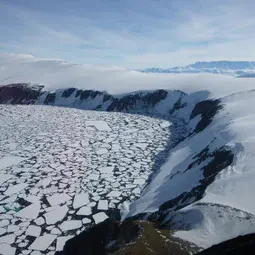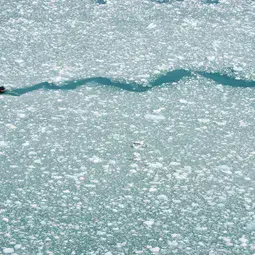The Antarctica Factor: model uncertainties reveal upcoming sea-level risk
14 February 2020
Sea-level rise due to ice loss in Antarctica could become a major risk for coastal protection even in the near term, scientists say. Within this century already, due to Antarctica alone, global sea level might rise up to three times as much as it did in the last century. This is a finding of an exceptionally comprehensive comparison of state-of-the-art computer models from around the world.
“The ‘Antarctica Factor’ turns out to be the greatest risk, and also the greatest uncertainty, for sea levels around the globe,” says lead-author Anders Levermann from the Potsdam Institute of Climate Impact Research (PIK) and Columbia University’s LDEO in New York. “While we saw about 19 centimeters of sea-level rise in the past 100 years, Antarctic ice loss could lead to up to 58 centimeters within this century. Coastal planning cannot merely rely on the best guess. It requires a risk analysis. Our study provides exactly that: The sea-level contribution of Antarctica is very likely not going to be more than 58 centimeters within this century.”
Thermal expansion of the ocean water under global warming and melting of mountain glaciers, which to date have been the most important factors for sea-level rise, will come on top of the contribution from Antarctic ice loss. The overall sea-level rise risk is thus even bigger, yet the ‘Antarctica Factor’ is about to become the most important one, according to the study now published in the journal Earth System Dynamics of the European Geosciences Union (EGU).
Large range of estimates makes the results very robust
The range of sea-level rise estimates from the ‘Antarctica Factor’ provided by the scientists is rather large. Assuming that humanity keeps on emitting greenhouse gases as before, the range the scientists call “very likely” to capture the future is between 6 and 58 centimeters for this century. If greenhouse gas emissions were to be reduced rapidly, it is between 4 and 37 centimeters. Importantly, the difference between a scenario of business-as-usual and a scenario of emissions reductions becomes substantially greater on longer timescales, hence farther in the future.
The researchers accounted for a number of uncertainties in the computations, from the atmospheric warming response to carbon emissions to oceanic heat transport to the Southern Ocean. Sixteen ice sheet modeling groups comprised of 36 researchers from 27 institutes contributed to the new study, which was coordinated by PIK. A similar study six years earlier had to rely on the output of only five ice sheet models. This development reflects the increasing importance of research on the Antarctic ice sheet.
“Risks for coastal metropolises from New York to Mumbai, Hamburg to Shanghai”
“The more computer simulation models we use, all of them with slightly different dynamic representations of the Antarctic ice sheet, the wider the range of results that we yield – but also the more robust the insights that we gain,” says co-author Sophie Nowicki of the NASA Goddard Space Flight Center and lead author of the Intergovernmental Panel on Climate Change, who led the overarching ice sheet model intercomparison project, ISMIP6. “There are still large uncertainties, but we are constantly improving our understanding of the largest ice sheet on Earth. Comparing model outputs is a forceful tool to provide society with the necessary information for rational decisions.”
Over the long term the Antarctic ice sheet has the potential to raise sea level by tens of meters. “What we know for certain,” says Levermann, “is that not stopping to burn coal, oil and gas will drive up the risks for coastal metropolises from New York to Mumbai, Hamburg or Shanghai.”
###
Please mention the name of the publication (Earth System Dynamics) if reporting on this story and, if reporting online, include a link to the paper (https://www.earth-syst-dynam.net/11/35/2020/ or to the journal website (https://www.earth-system-dynamics.net/).
More information
This research is presented in the paper “Projecting Antarctica’s contribution to future sea level rise from basal ice shelf melt using linear response functions of 16 ice sheet models (LARMIP-2)” published in the EGU open access journal Earth System Dynamics on 14 February 2020.
Citation: Levermann, A., Winkelmann, R., Albrecht, T., Goelzer, H., Golledge, N. R., Greve, R., Huybrechts, P., Jordan, J., Leguy, G., Martin, D., Morlighem, M., Pattyn, F., Pollard, D., Quiquet, A., Rodehacke, C., Seroussi, H., Sutter, J., Zhang, T., Van Breedam, J., Calov, R., DeConto, R., Dumas, C., Garbe, J., Gudmundsson, G. H., Hoffman, M. J., Humbert, A., Kleiner, T., Lipscomb, W. H., Meinshausen, M., Ng, E., Nowicki, S. M. J., Perego, M., Price, S. F., Saito, F., Schlegel, N.-J., Sun, S., and van de Wal, R. S. W.: Projecting Antarctica’s contribution to future sea level rise from basal ice shelf melt using linear response functions of 16 ice sheet models (LARMIP-2), Earth Syst. Dynam., 11, 35–76, https://doi.org/10.5194/esd-11-35-2020, 2020.
The European Geosciences Union (EGU) is the leading organisation for Earth, planetary and space science research in Europe. With our partner organisations worldwide, we foster fundamental geoscience research, alongside applied research that addresses key societal and environmental challenges. Our vision is to realise a sustainable and just future for humanity and for the planet. We publish a number of diverse scientific journals, which use an innovative open access format, and organise topical meetings, and education and outreach activities. The annual EGU General Assembly is the largest and most prominent European geosciences event, attracting more than 16,000 scientists from all over the world in 2019. The meeting’s sessions cover a wide range of topics, including volcanology, planetary exploration, the Earth’s internal structure and atmosphere, climate, as well as energy and resources. The EGU General Assembly 2020 is taking in Vienna, Austria, from 3 to 8 May. For information and press registration, please check https://www.egu.eu/gamedia closer to the time of the event, or follow the EGU on Twitter and Facebook.
If you wish to receive our press releases via email, please use the Press Release Subscription Form at https://www.egu.eu/news/subscribe/. Subscribed journalists and other members of the media receive EGU press releases under embargo (if applicable) 24-48 hours in advance of public dissemination.
Earth System Dynamics (ESD) is a not-for-profit international scientific journal dedicated to the publication and public discussion of studies that take an interdisciplinary perspective of the functioning of the whole Earth system and global change.
Contact
Scientist
Dr. Anders Levermann
Professor of Dynamics of the Climate System
Potsdam Institute for Climate Impact Research (PIK)
Potsdam, Germany
Email Anders.Levermann@pik-potsdam.de
Press officer
Terri Cook
Head of Media, Communications and Outreach
European Geosciences Union
Munich, Germany
Phone +49-89-2050-76340
Email media@egu.eu
X @EuroGeosciences


